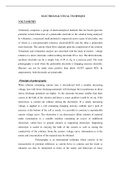Class notes
Class notes MSc chemistry Electroanalytical Methods, ISBN: 9783662047576
- Course
- Institution
- Book
This notes are class notes of advanced physical chemistry for the course of post graduation and further doctoral studies. It explains about electroanalytical methods in chemistry.
[Show more]



